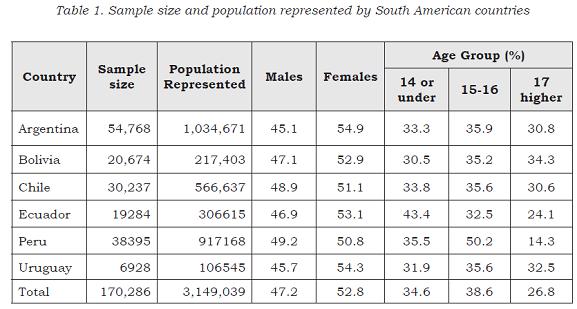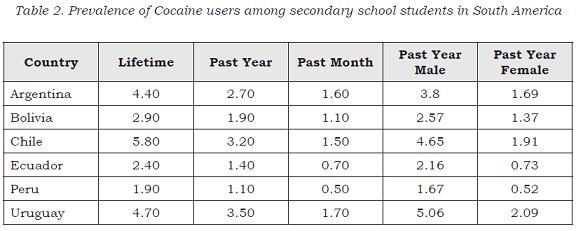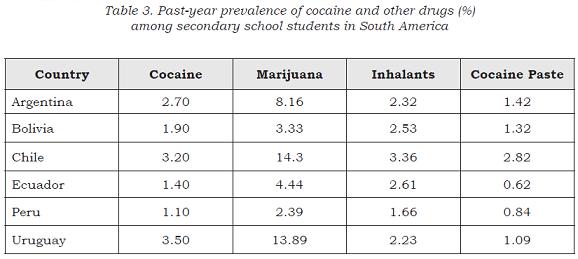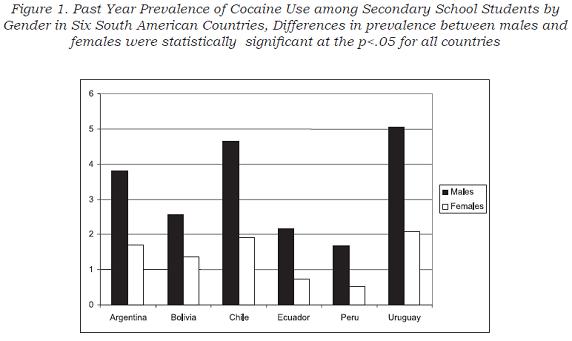Serviços Personalizados
Journal
Artigo
Indicadores
-
 Citado por SciELO
Citado por SciELO -
 Acessos
Acessos
Links relacionados
-
 Citado por Google
Citado por Google -
 Similares em
SciELO
Similares em
SciELO -
 Similares em Google
Similares em Google
Compartilhar
Revista Colombiana de Psiquiatría
versão impressa ISSN 0034-7450
rev.colomb.psiquiatr. v.39 supl.1 Bogotá fev. 2010
Cocaine Use among High School Students in Six South American Countries
Uso de cocaína entre estudiantes de secundaria en seis países de Suramérica
Marya Hynes Dowell1
Héctor Suárez2
Francisco Cumsille3
1 Organization of American States, Inter-American Drug Abuse Control Commission (CICAD) Inter-American Observatory on Drugs (OID), Red Latinoamericana de Investigadores en Drogas (REDLA). Uruguay.
2 Licenciado, Observatorio Uruguayo sobre Drogas (OUD). Uruguay.
3 Dr. Ph. Organization of American States, Inter-American Drug Abuse Control Commission (CICAD) Inter-American Observatory on Drugs (OID).
Conflicto de interés: los autores manifiestan que no tienen ningún conflicto de interés en este artículo.
Correspondencia Marya Hynes Dowell Red Latinoamericana de Investigadores en Drogas (REDLA) Uruguay mhynes@oas.org
Recibido para evaluación: 13 de mayo del 2010 Aceptado para publicación: 21 de julio del 2010
Abstract
Objectives: To compare lifetime and past year prevalence estimates of cocaine use among secondary school students in six South American countries. Methods: Data are from the 2009 Inter-American Drug Abuse Control Commission (CICAD) and United Nations Office on Drug Control Policy (UNODC) collaborative study on drug use; with national representative samples of over 170,286 secondary school students in Argentina, Bolivia, Chile, Peru, and Uruguay. Results: Cocaine was the second most commonly reported illicit substance used following marijuana in Argentina and Uruguay, and was the most common illicit substance following marijuana and inhalants in the other four countries surveyed. Past year use ranged from a high of 3.5% in Uruguay to a low of 1.1% in Peru. Conclusions: Cocaine prevalence shows a worrisome pattern among high school students in South America. Rates in Argentina, Chile and Uruguay are close to the United States and Canada. This analysis provides evidence to support the notion that cocaine use is a problem in South American countries, particularly among those that have no known history of cocaine production. Implications for drug policy, health among teenagers and education in Latin America are discussed.
Key words: Cocaine, street drugs, use, adolescents, South America.
Resumen
Objetivos: Comparar la prevalencia de vida y el último año del consumo de cocaína entre estudiantes de secundaria en seis países de Suramérica. Métodos: Los datos son del 2009 y fueron recogidos en el Estudio Colaborativo de Uso de Drogas de la Agencia Interamericana para el Control del Abuso de Drogas (CICAD) y la Oficina de Naciones Unidas de Control de Drogas (ONUDD). Las muestras fueron representativas de más de 170.286 estudiantes de secundaria en Argentina, Bolivia, Chile, Perú y Uruguay. Resultados: La cocaína fue la segunda droga más utilizada después de la marihuana en Argentina y Uruguay, y fue la sustancia ilegal más común después de la marihuana y los inhalantes en los otros cuatro países estudiados. La prevalencia del uso de cocaína en el último año osciló entre un máximo del 3,5% en Uruguay a un mínimo del 1,1% en el Perú. Conclusiones: La prevalencia de uso de cocaína presenta un patrón preocupante entre los estudiantes de secundaria en América del Sur. Las prevalencias en Argentina, Chile y Uruguay están cerca de la de Estados Unidos y Canadá. Este análisis proporciona pruebas que apoyan la idea de que el consumo de cocaína es un problema en los países suramericanos, especialmente en los que no tienen antecedentes conocidos de la producción de esta droga. Se discuten las implicaciones para la política de drogas, la salud entre los adolescentes y la educación en América Latina.
Palabras clave: Cocaína, drogas ilícitas, adolescentes, América del Sur.
Introduction
Recent information from the Inter-American Drug Abuse Control Commission (CICAD) and the United Nations Office on Drugs and Crime (UNODC) indicate that substance use among secondary school (high school students) is a major issue concern in South America. Although in previous studies illicit drug use has been lower in South American countries than in the United States (1-3), international reports indicate a growing problem among this population (4). For example, a 2004 comparative study among high school students in nine South American countries showed past year prevalence rates of cocaine ranging from 0.9% in Bolivia to 2.5% in Argentina. A follow up study carried out in 2009 among six countries, showed that cocaine prevalence had increased in each of the six countries studied.
Unfortunately, although national reports exist, there are few published articles readily accessible to international audiences on drug use among high school students in South America. The purpose of this paper is to summarize the current prevalence rates of cocaine use among high school students in the six South American countries that participated in the CICAD/UNODC 2009 study.
Methods
Data for this study were taken from the first comparative study on drug use in South American youth, Informe Subregional sobre Uso de Drogas en Población Escolarizada: Información para el Diseño de las Estrategias Nacionales y Regionales sobre la Problemática de Drogas en Jóvenes. This comparative study of drug use in six South American countries was conducted in 2009 and was a joint effort between the Inter-American Drug Abuse Control Commission (CICAD) of the Organization of American States (OAS) and the United Nations Drug Control Programme (UNODC) through its regional office in Peru. The participating countries were Argentina, Bolivia, Chile, Ecuador, Peru and Uruguay (4).
Research Design
The study used a cross-sectional design modeled after national surveys of school attending youth and previously conducted in Latin America and the United States (i.e., Monitoring the Future). Each country had a lead researcher and a research team. Data were collected during 2007-2008 school year. Field work in Argentina, Bolivia, Ecuador and Uruguay was executed directly by personnel contracted and supervised by the technical officers at the national drug commissions, which are the governmental entities in charge of dealing with the policies associated with the drug problem similar in nature to the National Office on Drug Control Policy (ON-DCP) in the United States. In Peru and Chile, external agencies were contracted to perform data collection and were overseen by the respective national drug offices. The grades selected correspond to 8th, 10th, and 12th grades. Students comprise three age groups: 14 years and younger, 15-16 years, and 17 years and older. Study implementation and data collection were carried out simultaneously in all six countries during the same 12 month period between 2007 and 2008, applying standardized instruments and a common methodology in order to avoid bias and to assure comparability of data across countries.
Sample
The study utilized a multistage sampling design to obtain nationally representative samples of secondary school students. The sample of students involved three stages: All countries, selected all of their corresponding geographic regions or provinces from where to draw a sample of schools. From each of the countries' regions, a random sample of schools was drawn. Schools were identified through the countries' national register of secondary schools during the school year in which the study was performed. The third stage consisted of randomly selecting classrooms from each of the schools sampled. Once a classroom was selected, all of the students were administered the questionnaire. This method was applied in each country with a slight variation in Chile where instead of the entire class taking the questionnaire, twenty students were selected randomly within each class to take the questionnaire. This was done in order to remain consistent with previous studies carried out in Chile through their national drug use surveillance system.
Measures
The instrument consisted of a standardized questionnaire in Spanish with items adjusted for linguistic differences where necessary depending on the local vernacular. The questionnaire consisted of three sections including questions about sociodemographic characteristics, prevalence and frequency of use of various substances (i.e., alcohol, cigarettes, coca base, cocaine, crack, ecstasy, hallucinogens, hashish, heroin marijuana, methamphetamine, morphine, opium, stimulants and tranquilizers) and perceptions of risk associated with the use of these substances. By consensus, the countries agreed on using the same format when administering the questionnaire. The format follows what is referred to as the 'common model' known as the Modelo de Cuestionario Subregionál' (MCS) (in English, Subregional Questionnaire Model) developed by the Organization of American States Inter-American Uniform Drug Use Survey (SIDUC). The common model consists of the administration of anonymous, selfapplied questionnaires, that gather information on the use of tobacco, alcohol, pharmaceutical use without a prescription (tranquilizers and stimulants), and illicit substances such as marijuana, cocaine, coca paste, and ecstasy in addition to inhalant use among secondary school students.
The dependent variables are defined as the proportion of students who used cocaine in their lifetime, in the past 12-months (past year), and in the past thirty days (past month). The following question was used to assess lifetime cocaine use, "Have you used (drug) anytime in your lifetime? The response option for cocaine reading was "cocaine". Subsequent questions asked "Have you used cocaine in the past 12 months?" and "Have you used cocaine in the past thirty days?"
Analysis
The distribution of lifetime and past 12 months cocaine use by sex and age group (12-14, 15-16, 17+) is provided by country. All percent values consist of weighted data. Sample weights were assigned to each student to take into account differences in population size and age-group structure across countries. The adjusted analyses in this study permit comparisons between countries. The prevalence rates in this study vary slightly from those reported by individual countries in their national reports because their analyses rely on unadjusted rates.
Results
Over 170,000 students from the equivalent of 8th, 10th, and 12th grades participated in the study, representing a population of more than 3,149,000 students. About 47% were males and 53% females. Approximately 34% were 14 or younger, 38.6% 15-16 years old, and 26.8% 17 years old or older (see Table 1).
Cocaine prevalence
As shown in Table 2, the highest prevalence of cocaine use can be found in Argentina, Chile and Uruguay for lifetime, past year and past month prevalence. Lifetime prevalence among high-school students in Argentina is 4.4%, 4.7% in Uruguay, and about 6.9% in Chile. The lowest lifetime prevalence's are in Peru (1.9%) in Ecuador (2.4%) and in Bolivia (2.9%) (Table 2).
Past year prevalence of cocaine, defined as any cocaine use during the twelve months prior to the survey, show prevalence rates of 2.7% in Argentina, 3.2% in Chile and 3.5% in Uruguay. The past year prevalence in Peru was 1.1%, 1.4% in Ecuador and 1.9% in Bolivia. Past month prevalence in ranged from .5% in Peru to 1.7% in Uruguay (Table 2).
Cocaine use vs. Other substances
When compared to the use of other substances, cocaine is the second most commonly used substance after marijuana in both Argentina and Uruguay. In Bolivia, Chile, Ecuador and Peru cocaine is the third most commonly used drug following marijuana and inhalants.
Gender Differences
When we look at cocaine use by gender, we see that male high school students use cocaine at higher rates than the female counterparts in every country in the study. The ratios of past year use males: females range from just around 2:1 in Bolivia to over 3:1 in Peru. The past year prevalence of cocaine use among males was 3.8% in Argentina, 2.57% in Bolivia, 4.65% in Chile, 2.16% in Ecuador, 1.67% in Peru and 5.06% in Uruguay. In contrast the past year prevalence of cocaine use among females in the same six countries was 1.7% in Argentina, 1.4% in Bolivia, 1.9% in Chile, 0.7% in Ecuador, 0.5% in Peru and 2.1% in Uruguay (Table 2). Differences according to gender were statistically significant at the p <.05 level in each individual country
Cocaine Use across Age Groups
The prevalence of cocaine use in the student population increases with age. In Figure 1 we can see that in each of the six countries surveyed, there higher prevalence in each consecutively older age group. Highest past year prevalence was found in the age 17 and older group in every country. The largest rate increases could be seen in Uruguay, where the prevalence more than doubled between the 14 and under age group and the 15-16 age group. The prevalence nearly doubled again between the 15-16 year group and oldest students. Differences in these age groups were statistically significant at the p <.05 level in each country individually.
Discussion
Data from this study comes from students in public and private secondary schools, roughly the equivalent of 'high school' in the United States. This analysis demonstrates that cocaine is an important substance of abuse among high school students in all six of the countries that participated in this study. Indeed, in Argentina, Chile and Uruguay, past year cocaine prevalence among high school students reach rates between 2.7% and 3.5% Prevalence in the highest three countries are not very different from rates seen in North America. Lifetime prevalence in both Uruguay and Chile are exceed the reported lifetime prevalence among high-school in the United 3.0% past year States (2,3) and are similar to estimates from Canada 4.4% lifetime cocaine use among high school students as reported by the Youth Smoking Survey 2006-2007 (5). By comparison, past year prevalence of cocaine use among high school students in the United States is about 3.0% (2,3). In addition, estimates of past month use for Argentina, Chile and Uruguay were also similar to the past month rate in the United States, 1.2% for 10th Grade and 1.9% for 12th grade according to MTF (2,3).
When we look at cocaine use by gender, it appears that cocaine prevalence is substantially higher among males than females. The past year prevalence of cocaine use was between two and three times higher among male than female students in each of the countries.
When we look at cocaine use compared to other substances, excluding alcohol and tobacco, cocaine is the second most common substance used during the past year in Argentina and Uruguay following marijuana, and it is third in each of the others following marijuana and inhalants. In contrast, the prevalence cocaine among high school students in the United States trails marijuana, inhalants, amphetamines, a variety of narcotics other than heroin, barbiturates, and hallucinogens other than LSD (2,3).
This should be a matter of public health concern for these countries. Previous research in the United States has shown that although other substances such as alcohol and marijuana have higher prevalence rates in the United States and many other countries, dependency among cocaine users develops more quickly than the risk for dependence on marijuana or alcohol (6). This implies a burgeoning drug use problem in this countries, while proximity to cocaine producing countries may allow further access to cocaine, creating greater potential for cocaine use to grow in severity.
The results of this study draw attention to the fact that cocaine is a drug consumed across the Americas. Cocaine use may be a major public health problem developing in South America, particularly those countries in the Southern cone.
Limitations
The data from the present study are cross sectional, and therefore do not allow us to observe cohort trends in all six countries. Nevertheless, the SIDUC program has carried out similar studies carried in the past. Peru, Ecuador and Bolivia, do not have multiple years of data allowing us to observe a clear trend. However these three countries participated in one previous sub-regional study among high school students in 2006, which applied the same methodology and questionnaire as the present 2009 study. In the 2006 study Bolivia's past year cocaine prevalence among high school students was 0.9%, much lower than the reported 1.9% for this study. Ecuador and Peru showed much more modest increases between 2006 and 2009. Peru's 2006 high school survey showed a past year cocaine prevalence of 1%, and Ecuador in 2006 was 1.2% now 1.4.
Argentina, Chile and Uruguay have independently carried out their own surveys prior to this collaborative effort using the SIDUC methodology. Although these too are series of cross-sectional surveys carried out in different years between 2000 and 2007, the cumulative studies suggest that cocaine prevalence is increasing among high school students in Uruguay and Argentina, while the trend in Chile has been relatively stable.
An additional limitation is that the SIDUC instrument does not ask students about family income, therefore we use public versus private school as a proxy to separate upper and lower socioeconomic classes. This is a somewhat imprecise proxy, due to variability in school systems across countries.
Conclusions
There appears to be an established cocaine use problem among high school students in the six South American countries studied. The highest prevalence could be found in the three countries of the Southern Cone: Argentina, Chile and Uruguay. It may be important to note as well, that none of these three are known cocaine-producing countries.
Although not all of the countries in the study have enough data to define trends in use, Argentina, Chile, and Uruguay do possess data from multiple years, and further analysis could be done on changes in cocaine use over time. Future analyses may consider sociodemographic differences in drug use.
Acknowledgements
The work was supported through a collaborative effort between the United Nations Office on Drugs and Crime and Organization of American States through the Inter-American Drug Abuse
Control Commission (CICAD). Study design and project implementation was done through CICAD at the Inter-American Observatory on Drugs (OID). In addition, fieldwork was done through the National Drug Commissions of Argentina, Bolivia, Chile. Ecuador, Peru and Uruguay.
References
1. Inter-American Drug Abuse Control Commission, United Nations Office on Drugs and Crime. Jóvenes y drogas en países sudamericanos: un desafío para las políticas públicas. Proyecto Subregional. Lima: Tetis; 2006. [ Links ]
2. Johnston LD, O'Malley PM, Bachman JG, Schulenberg JE. Monitoring the Future National Survey Results On Drug Use 1975-2008. Volume I: Secondary school students. (NIH Publication No. 09-7402). Bethesda: National Institute on Drug Abuse; 2009. p. 721. [ Links ]
3. Johnston LD, O'Malley PM, Bachman JG, Schulenberg JE. Monitoring the future national results on adolescent drug use: overview of key findings 2008. (NIH Publication No. 09-7401). Bethesda: National Institute on Drug Abuse; 2009. [ Links ]
4. United Nations Office on Drugs and Crime, Inter-American Observatory on Drugs Inter-American Drug Abuse Control Commission. Second Comparative Study on Drug Consumption and Associated Factors among Secondary School Students. Washington: UNO-DC, CICAD; 2009. [ Links ]
5. Health Canada, Tobacco Control Program, Health Canada Supplementary Tables. Youth Smoking Survey 20062007 [ Internet] . [ citado 2010 Abr 10] . Disponible en: http://www.ccsa.ca/Eng/Statistics/Canada/Pages/StudentStatistics.aspx [ Links ]
6. Wagner F, Anthony J. From first drug use to drug depedence: developmental periods of risk for dependence upon marijuana cocaine and alcohol. Neuropsychopharmacology. 2002;26(4):479-88. [ Links ]


















